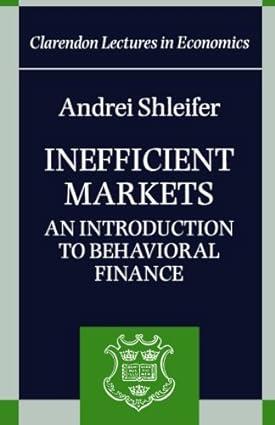Question
Problem 9-04 As an analyst for Charlotte and Chelle Capital, you are forecasting the market P/E ratio using the dividend discount model. Because the economy
Problem 9-04
As an analyst for Charlotte and Chelle Capital, you are forecasting the market P/E ratio using the dividend discount model. Because the economy has been expanding for 11 years, you expect the dividend-payout ratio will be at its low of 50 percent and that long-term government bond rates will rise to 8 percent. Because investors are becoming less risk averse, the equity risk premium will decline to 3 percent. As a result, investors will require a 11 percent return, and the return on equity will be 14 percent.
- What is the expected growth rate? Round your answer to one decimal place.
%
- What is your expectation of the market P/E ratio? Do not round intermediate calculations. Round your answer to two decimal places.
x
- What will be the value for the market index if the expectation is for earnings per share of $92? Do not round intermediate calculations. Round your answer to the nearest dollar.
$
--------
Problem 9-06
You are given the three EPS estimates and the following estimates related to the market earnings multiple:
| Pessimistic | Consensus | Optimistic | ||||
| EPS | $47.26 | $56.23 | $72.19 | |||
| D/E | 0.60 | 0.50 | 0.40 | |||
| Nominal RFR | 0.12 | 0.10 | 0.08 | |||
| Risk premium | 0.05 | 0.04 | 0.03 | |||
| ROE | 0.09 | 0.11 | 0.13 | |||
- Based on the three EPS and P/E estimates, compute the high, low, and consensus intrinsic market value for the S&P Industrials Index in 2018. Do not round intermediate calculations. Round your answers to the nearest cent.
High intrinsic market value: $
Low intrinsic market value: $
Consensus intrinsic market value: $
- Assuming that the S&P Industrials Index at the beginning of the year was priced at 2,200, compute your estimated rate of return under the three scenarios from Part a. Do not round intermediate calculations. Round your answers to one decimal place. Use a minus sign to enter negative rates of return, if any.
Rate of return (optimistic scenario): %
Rate of return (pessimistic scenario): %
Rate of return (consensus scenario): %
Assuming your required rate of return is equal to the consensus, how would you weight the S&P Industrials Index in your global portfolio?
One should (-----) the U.S. stocks in a global portfolio.
----------------
| eBook Problem 9-07 You are analyzing the U.S. equity market based upon the S&P Industrials Index and using the present value of free cash flow to equity technique. Your inputs are as follows:
| |||||||||||||||||||||
Step by Step Solution
There are 3 Steps involved in it
Step: 1

Get Instant Access to Expert-Tailored Solutions
See step-by-step solutions with expert insights and AI powered tools for academic success
Step: 2

Step: 3

Ace Your Homework with AI
Get the answers you need in no time with our AI-driven, step-by-step assistance
Get Started


